Abstract
Behavior dynamics is a field devoted to analytic descriptions of behavior change. A principal source of both models and methods for these descriptions is found in physics. This approach is an extension of a long conceptual association between behavior analysis and physics. A theme common to both is the role of molar versus molecular events in description and prediction. Similarities and differences in how these events are treated are discussed. Two examples are presented that illustrate possible correspondence between mechanical and behavioral systems. The first demonstrates the use of a mechanical model to describe the molar properties of behavior under changing reinforcement conditions. The second, dealing with some features of concurrent schedules, focuses on the possible utility of nonlinear dynamical systems to the description of both molar and molecular behavioral events as the outcome of a deterministic, but chaotic, process.
Keywords: dynamical systems, classical mechanics, mathematical models, chaotic dynamics, pigeons
Full text
PDF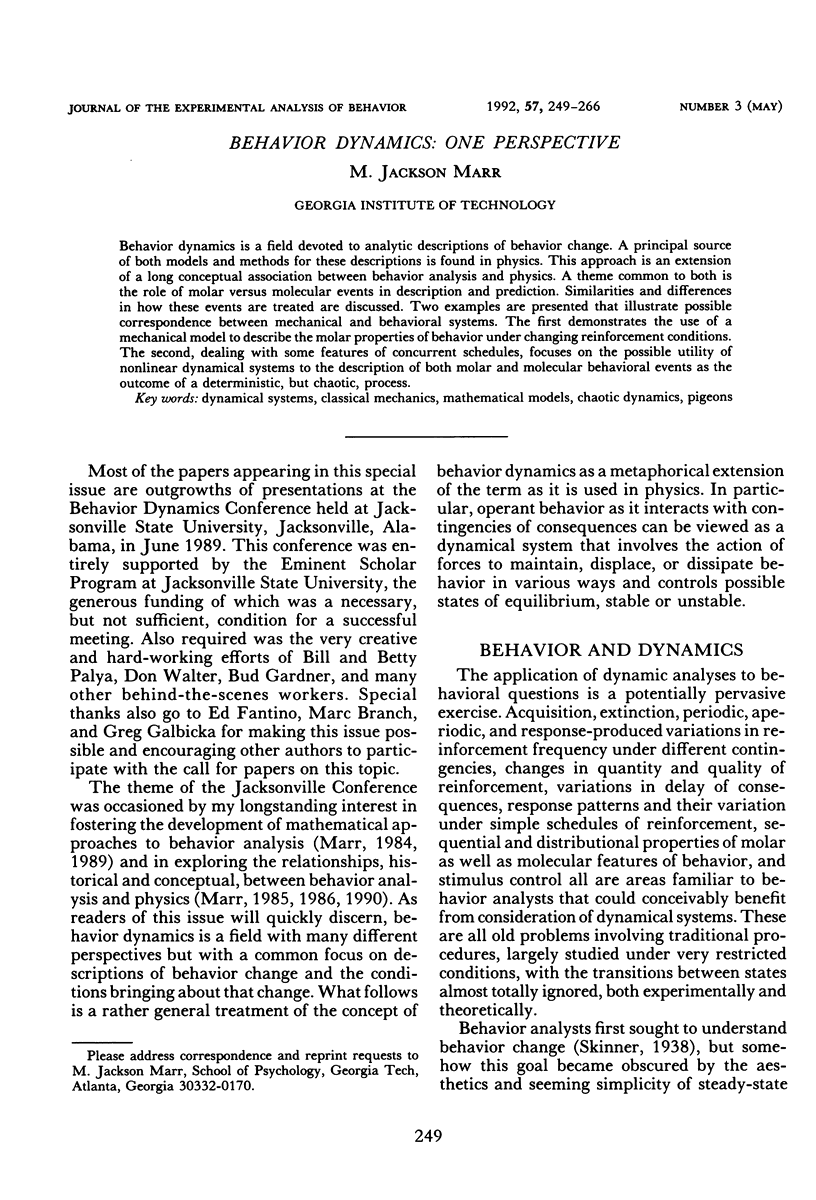

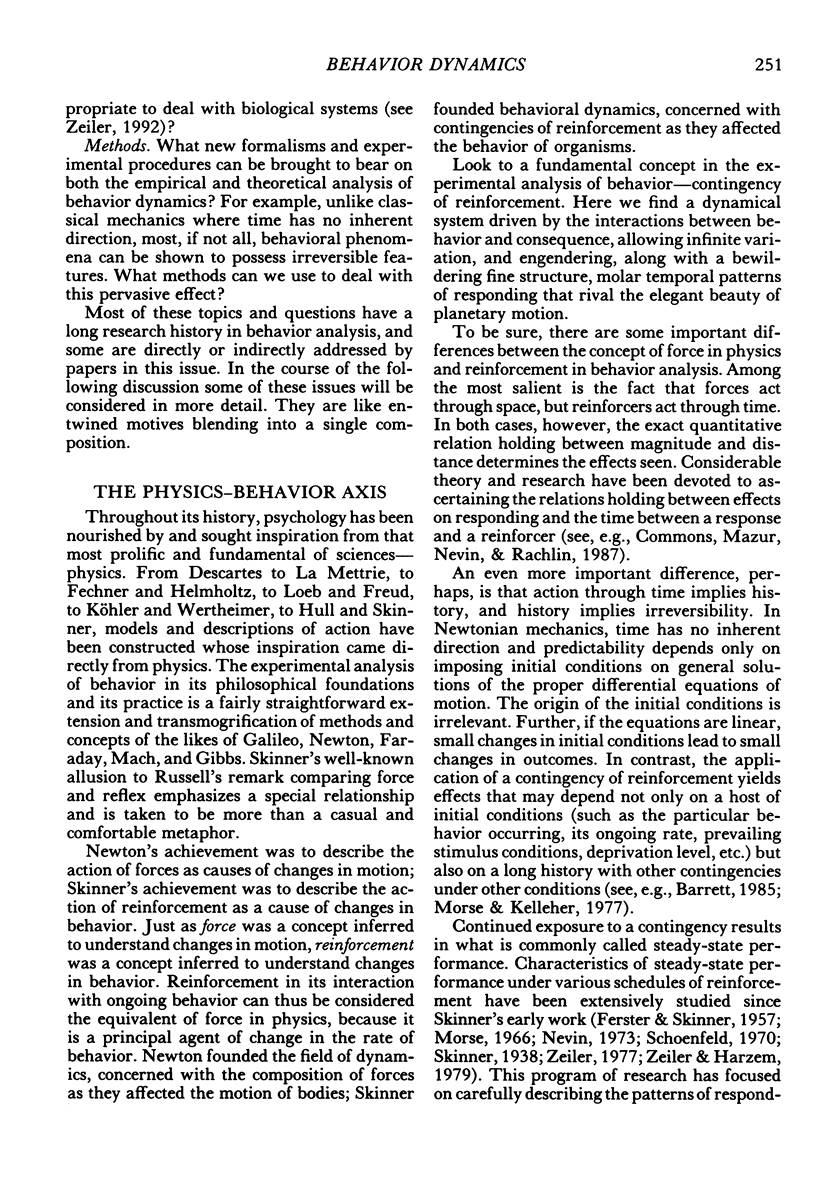
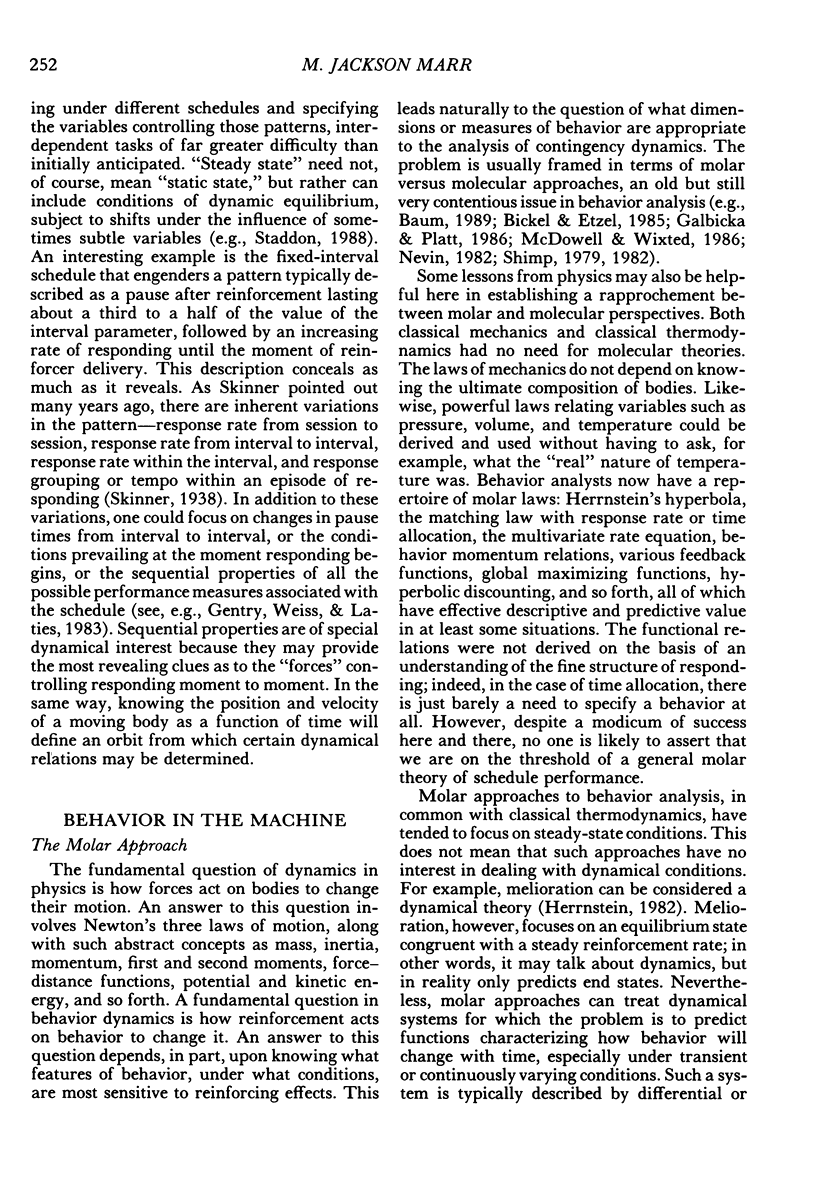
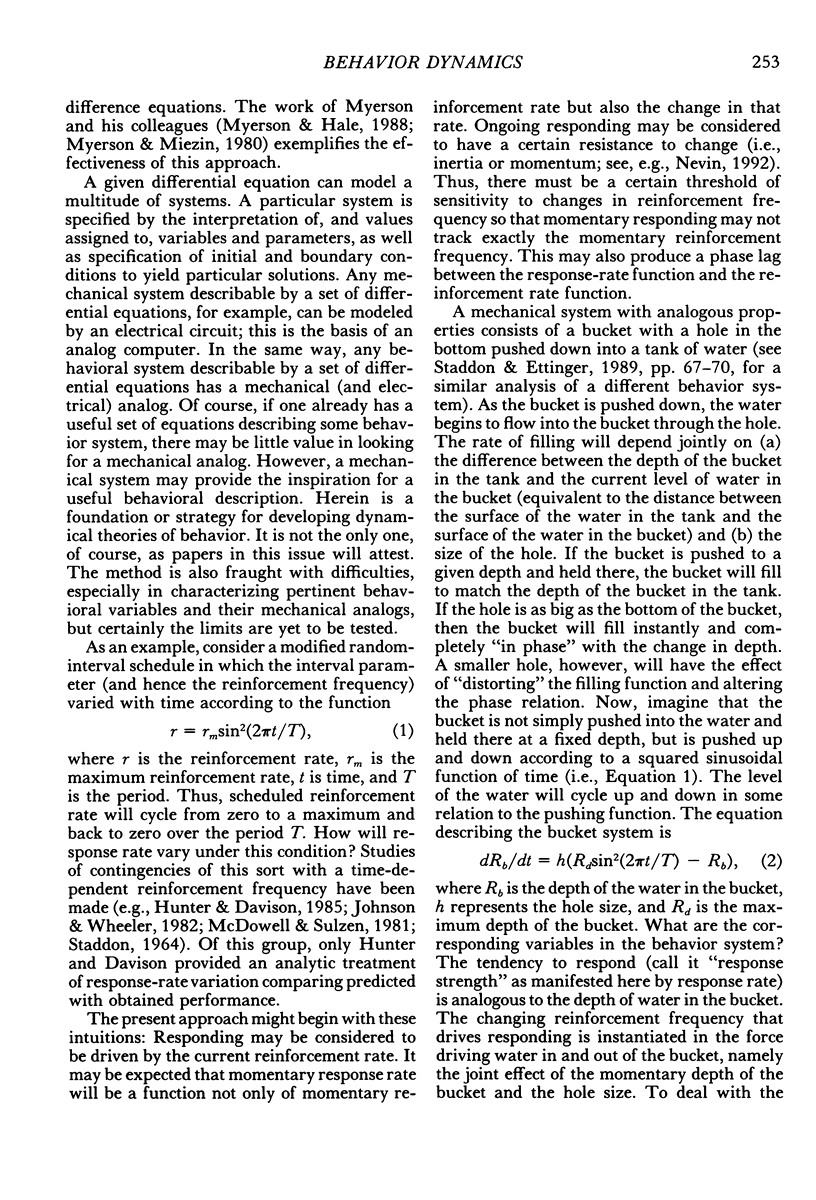
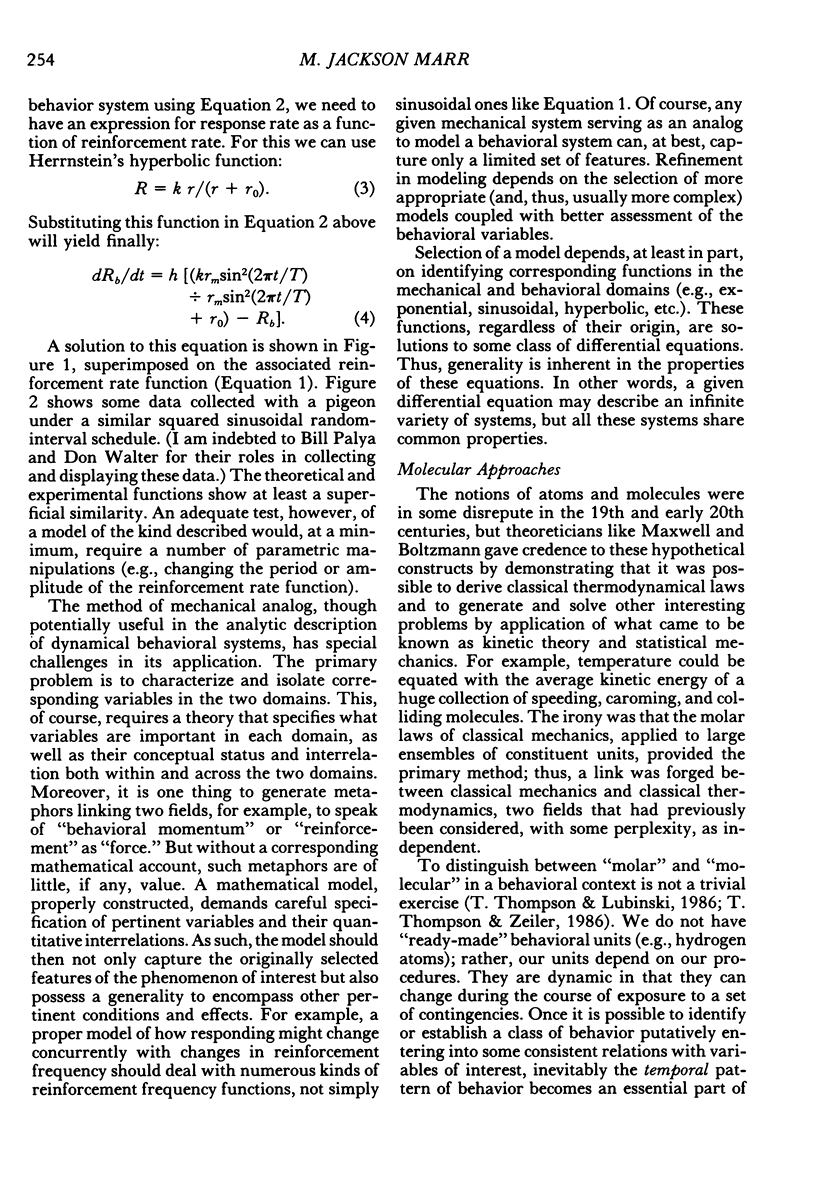
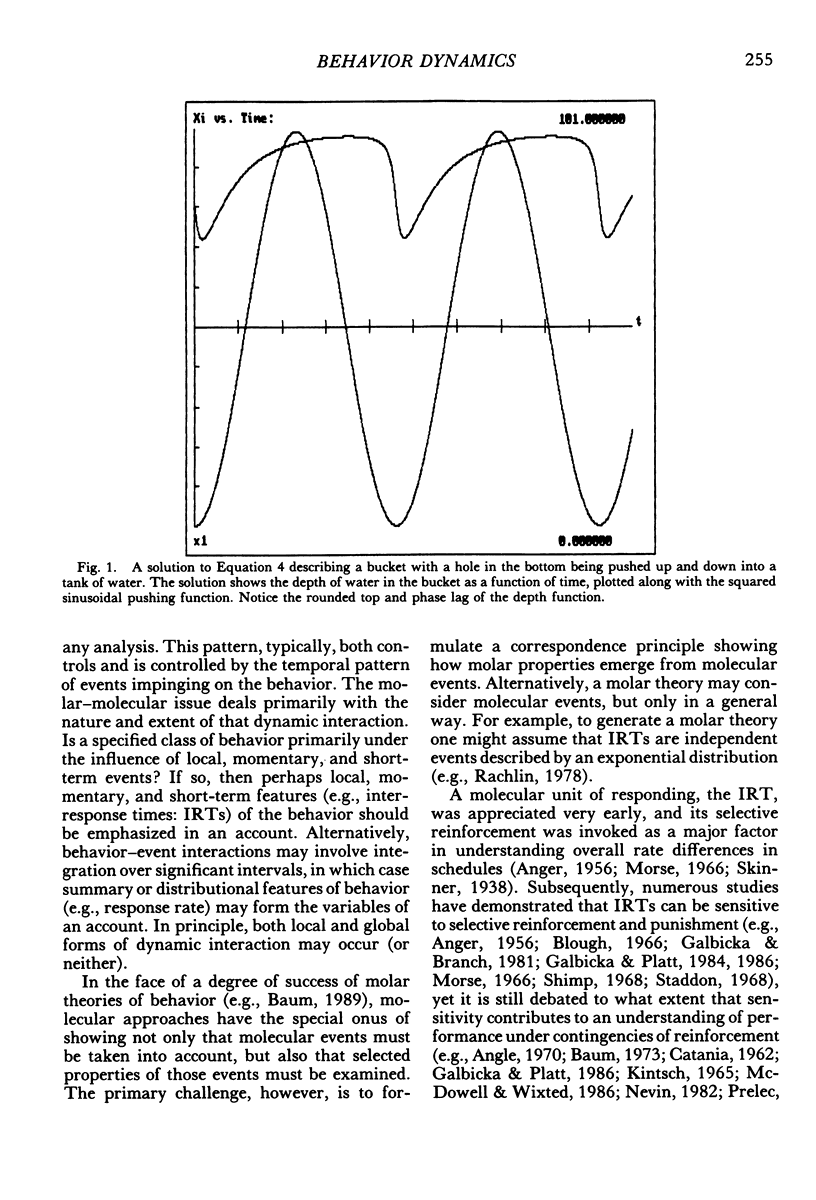
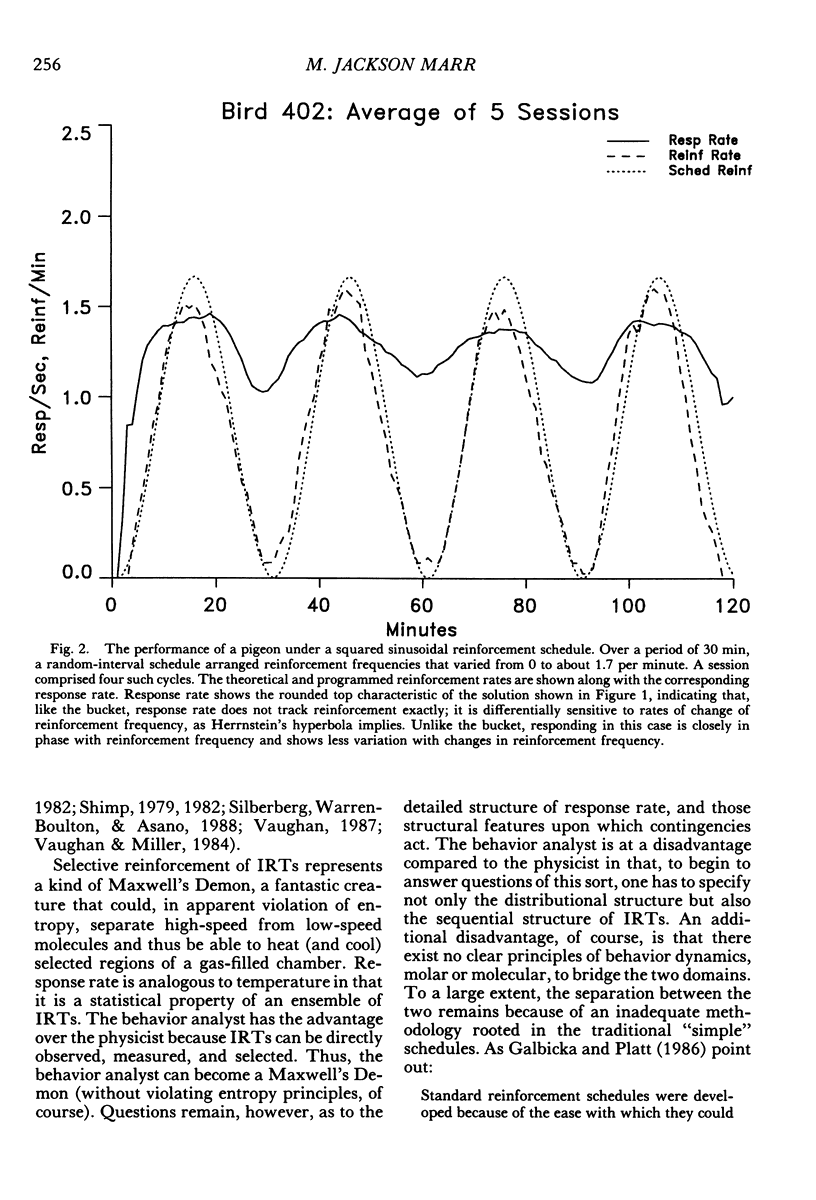
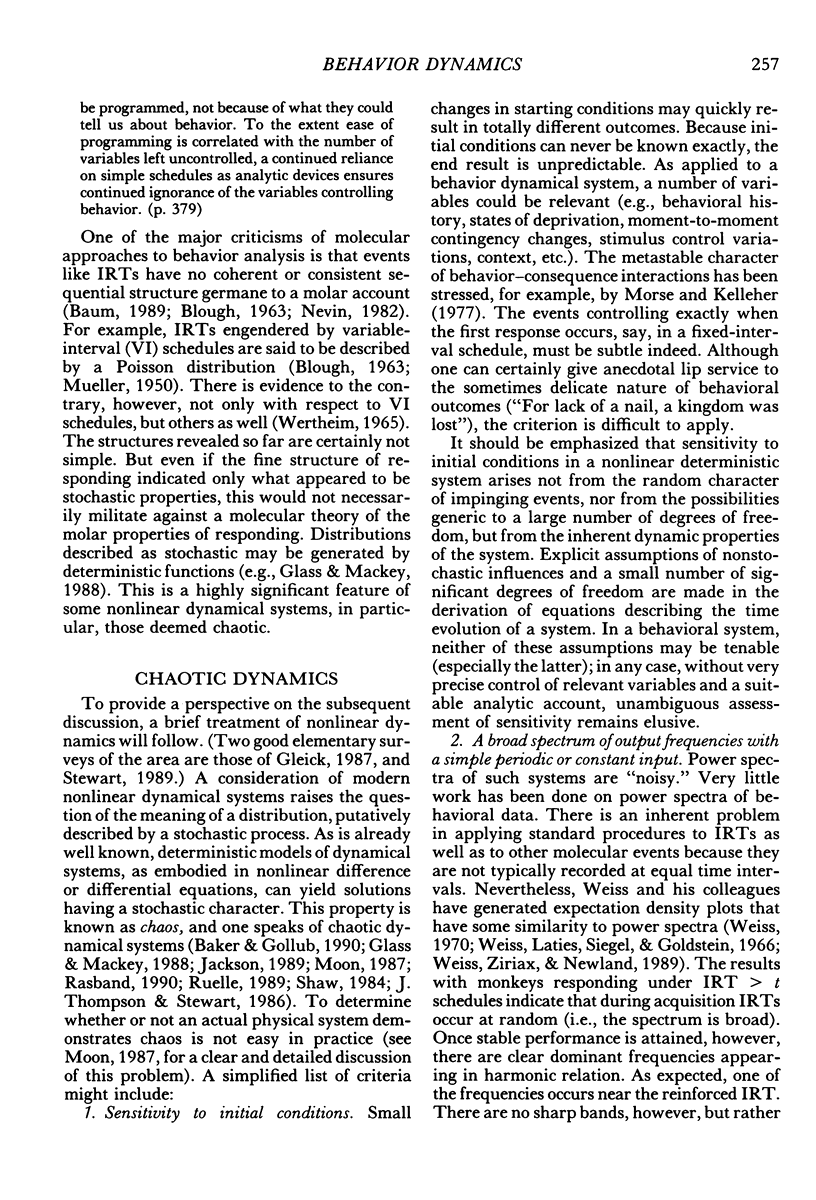
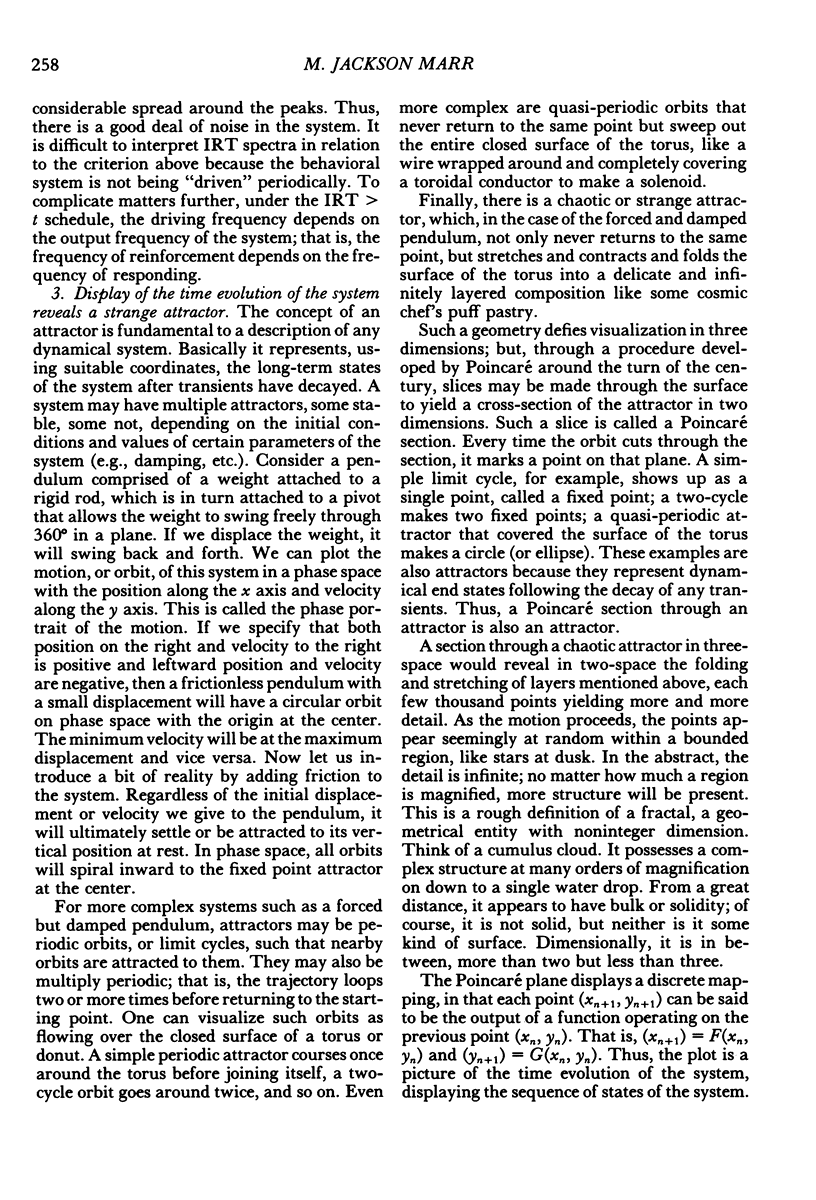
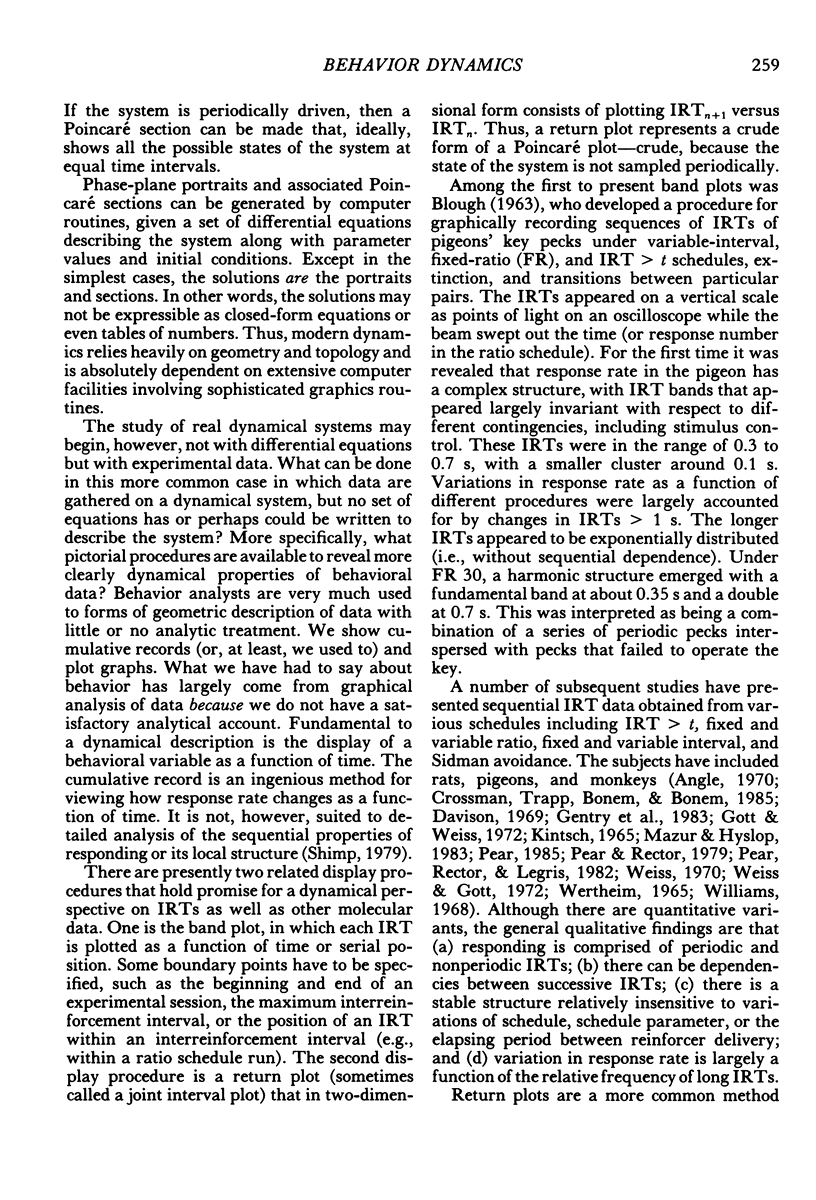
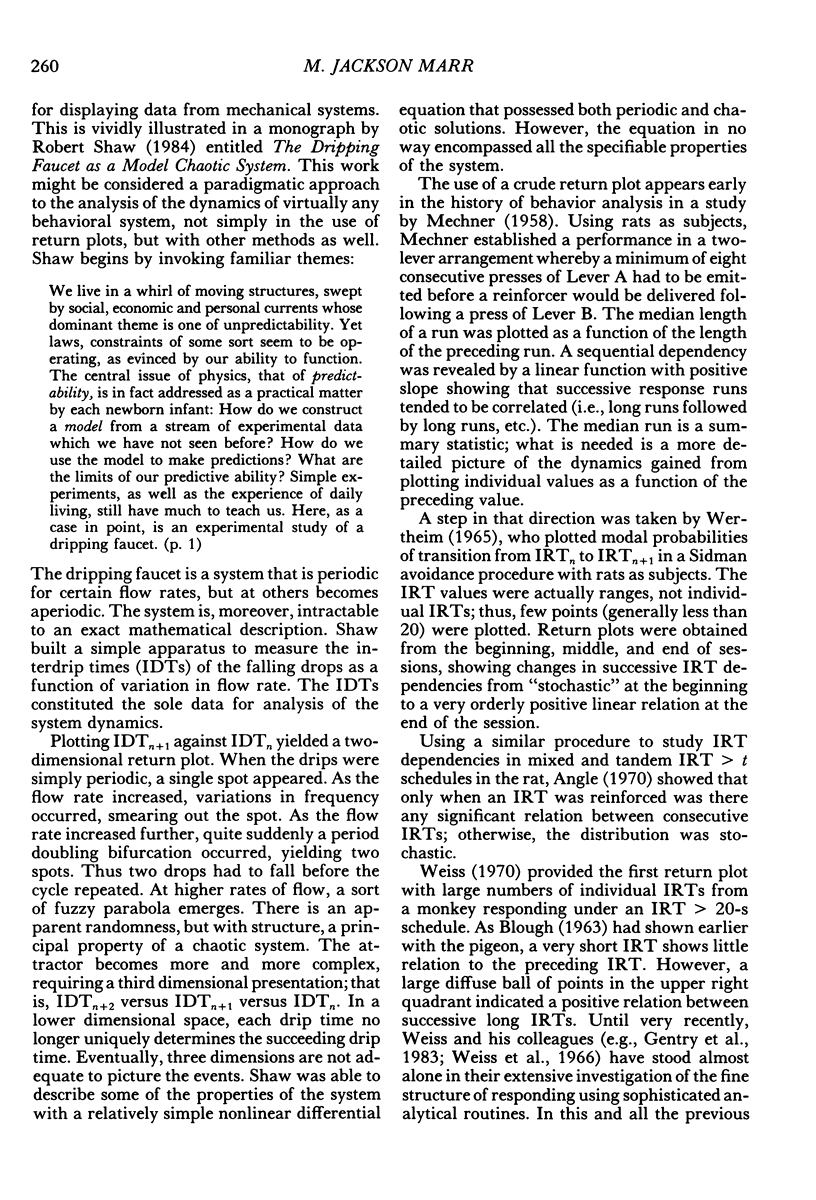
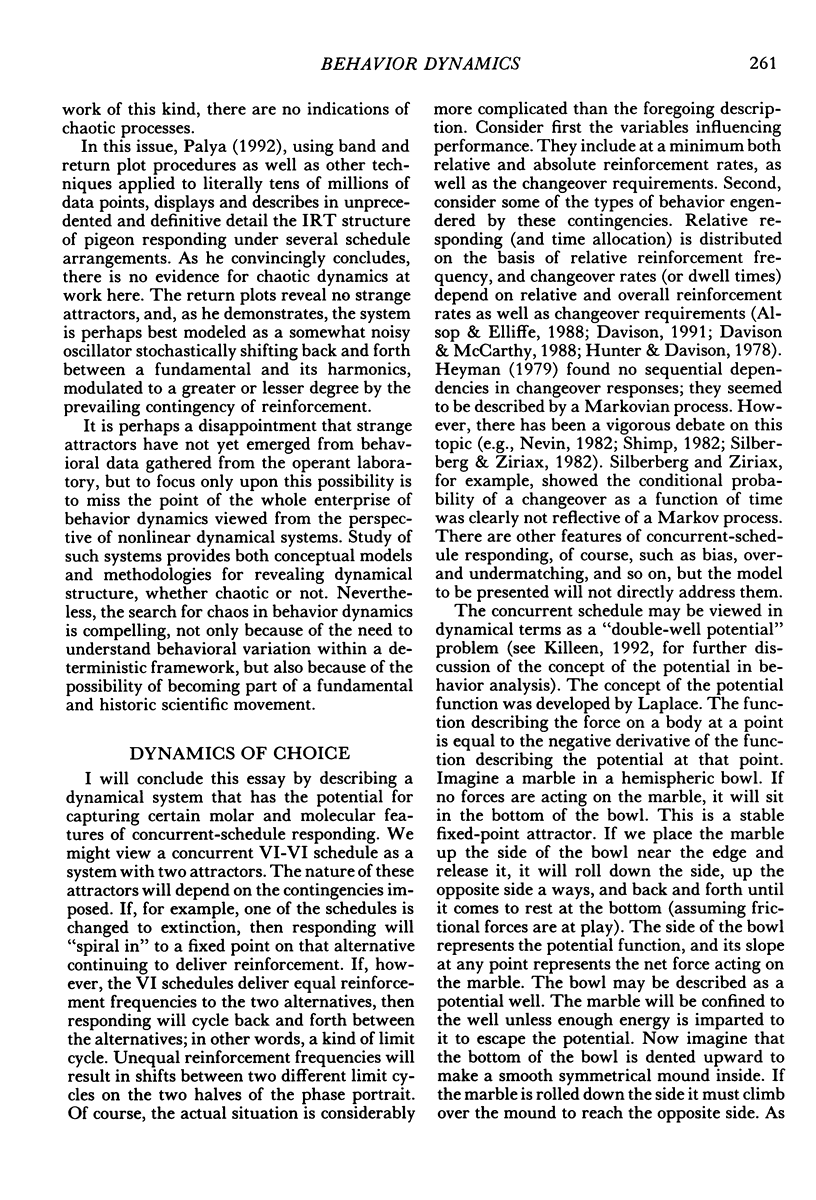
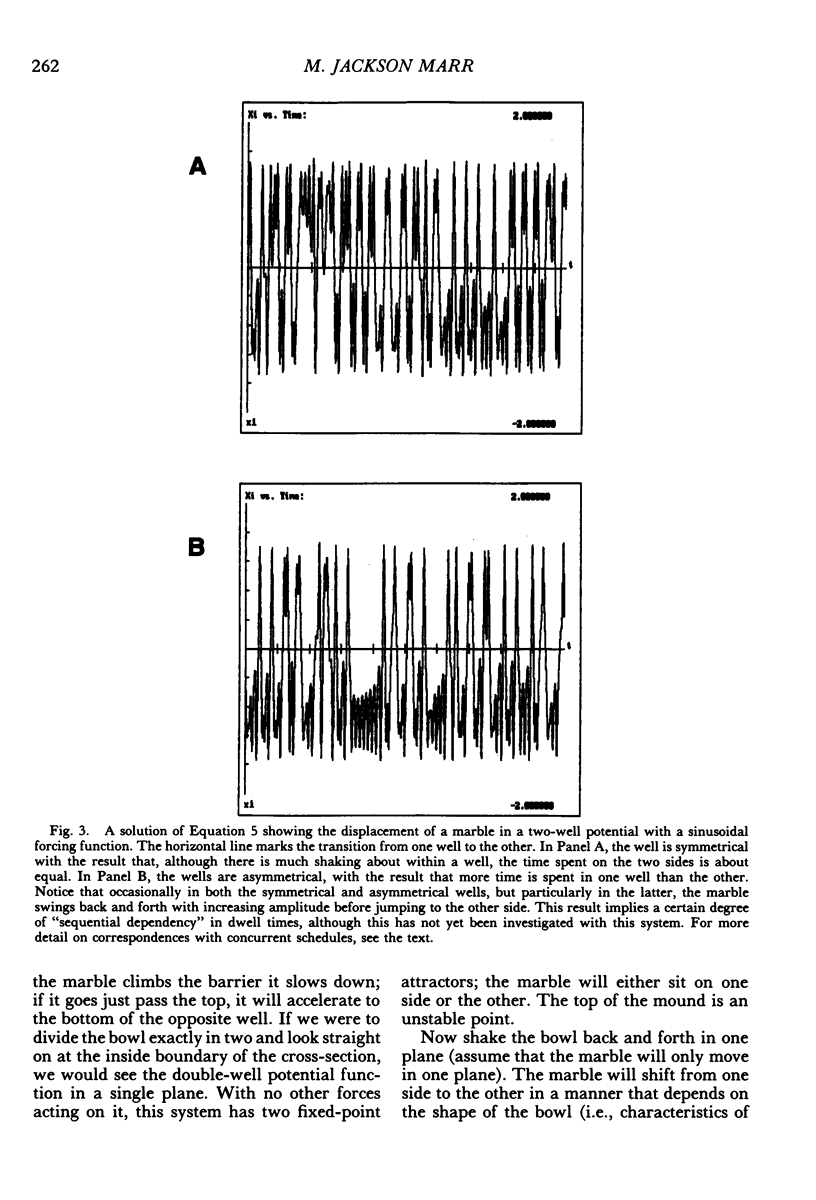
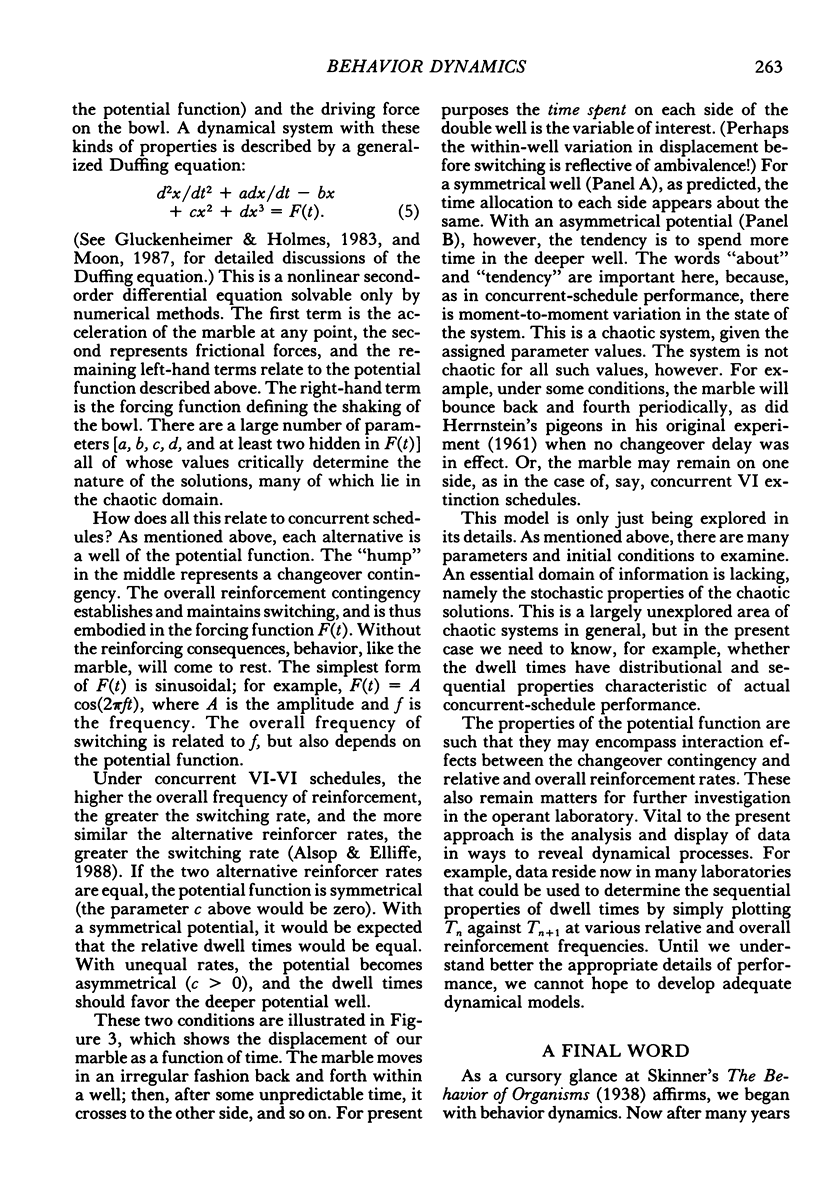
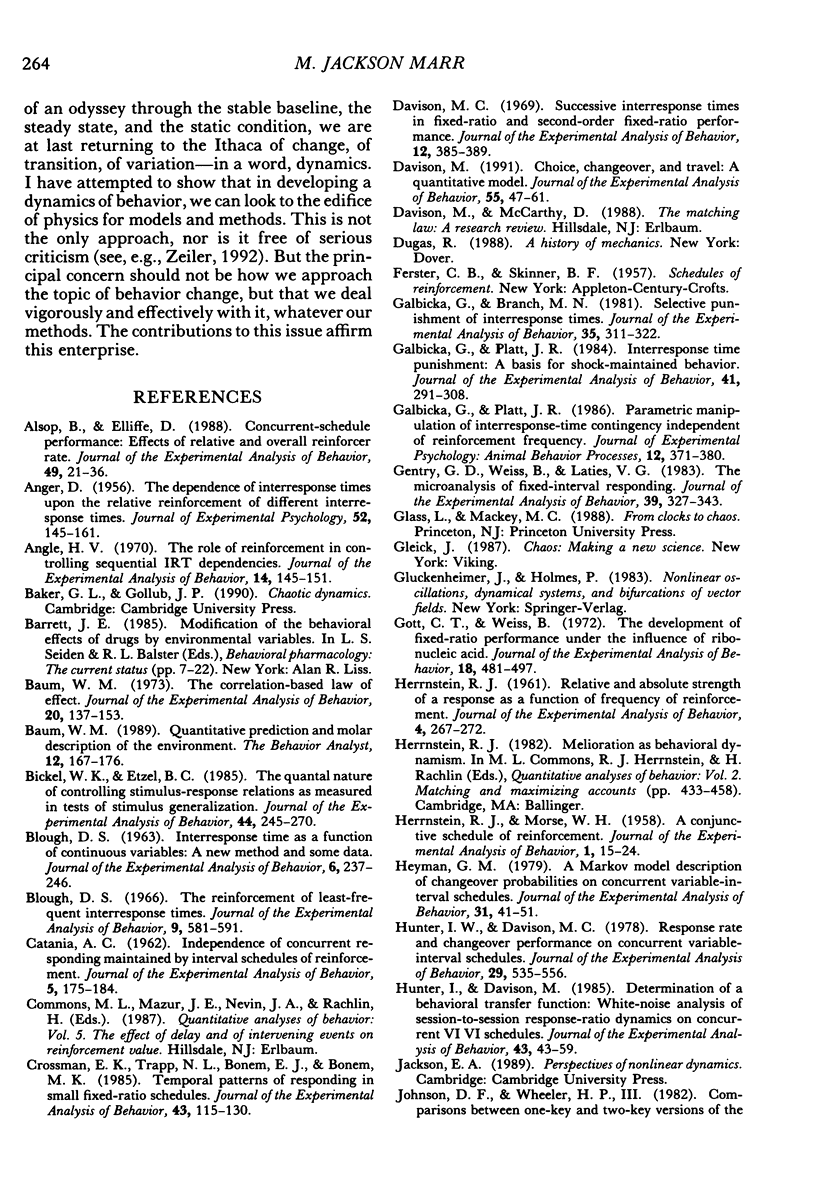
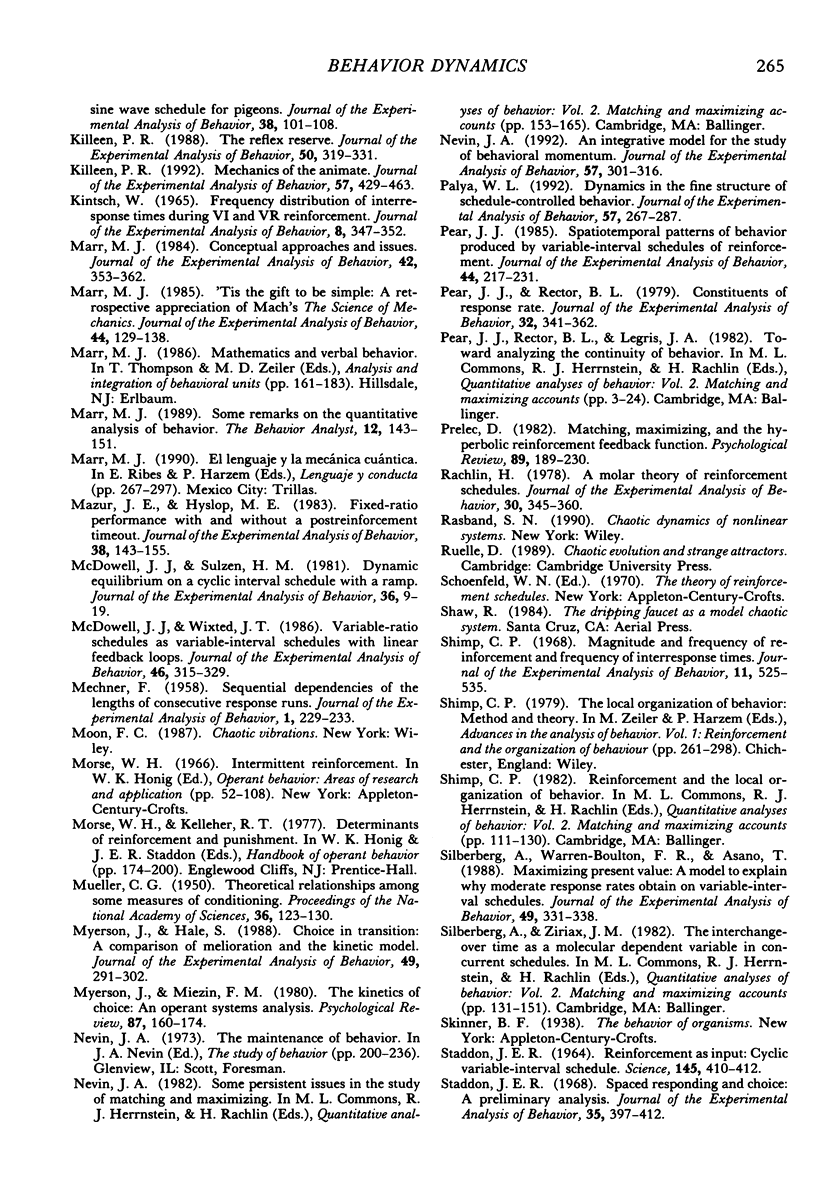
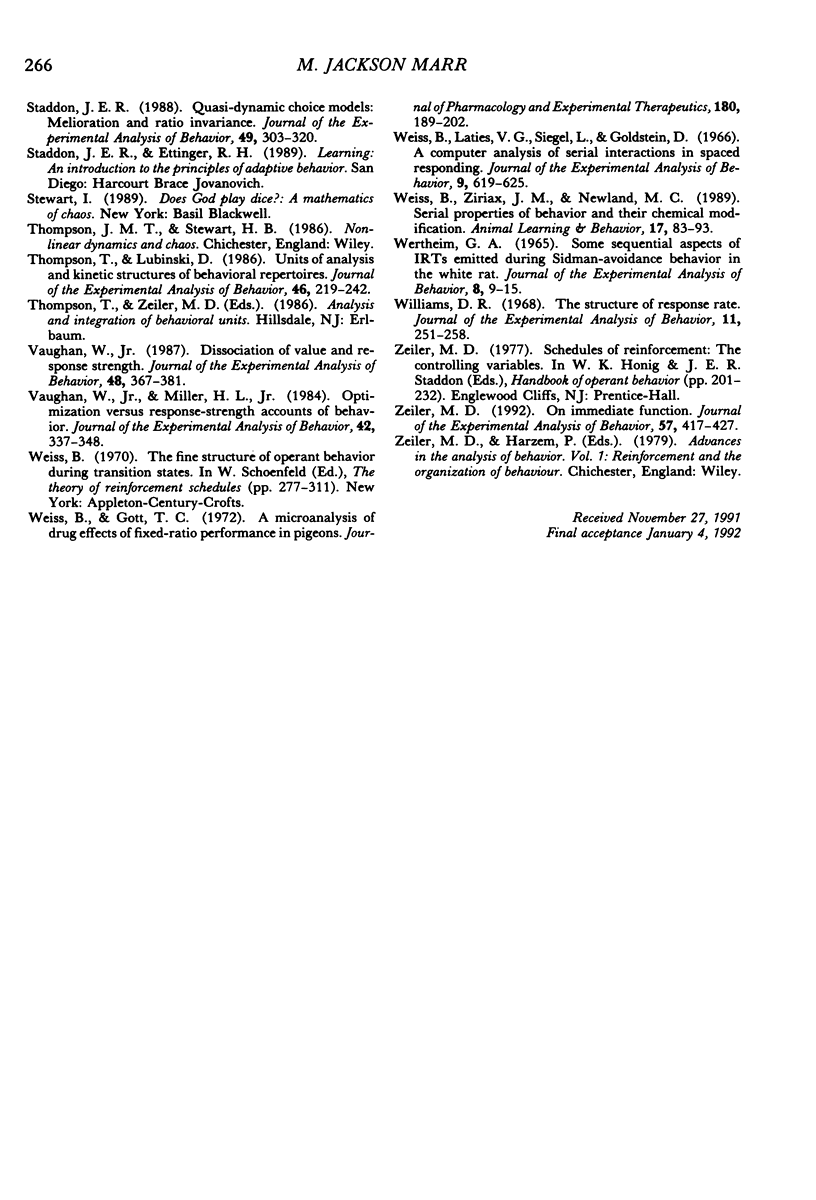
Selected References
These references are in PubMed. This may not be the complete list of references from this article.
- ANGER D. The dependence of interresponse times upon the relative reinforcement of different interresponse times. J Exp Psychol. 1956 Sep;52(3):145–161. doi: 10.1037/h0041255. [DOI] [PubMed] [Google Scholar]
- Alsop B., Elliffe D. Concurrent-schedule performance: Effects of relative and overall reinforcer rate. J Exp Anal Behav. 1988 Jan;49(1):21–36. doi: 10.1901/jeab.1988.49-21. [DOI] [PMC free article] [PubMed] [Google Scholar]
- Angle H. V. The role of reinforcement in controlling sequential IRT dependencies. J Exp Anal Behav. 1970 Sep;14(2):145–151. doi: 10.1901/jeab.1970.14-145. [DOI] [PMC free article] [PubMed] [Google Scholar]
- Baum W. M. The correlation-based law of effect. J Exp Anal Behav. 1973 Jul;20(1):137–153. doi: 10.1901/jeab.1973.20-137. [DOI] [PMC free article] [PubMed] [Google Scholar]
- Bickel W. K., Etzel B. C. The quantal nature of controlling stimulus-response relations as measured in tests of stimulus generalization. J Exp Anal Behav. 1985 Sep;44(2):245–270. doi: 10.1901/jeab.1985.44-245. [DOI] [PMC free article] [PubMed] [Google Scholar]
- Blough D. S. Interresponse time as a function of continuous variables: a new method and some data. J Exp Anal Behav. 1963 Apr;6(2):237–246. doi: 10.1901/jeab.1963.6-237. [DOI] [PMC free article] [PubMed] [Google Scholar]
- Blough D. S. The reinforcement of least-frequent interresponse times. J Exp Anal Behav. 1966 Sep;9(5):581–591. doi: 10.1901/jeab.1966.9-581. [DOI] [PMC free article] [PubMed] [Google Scholar]
- CATANIA A. C. Independence of concurrent responding maintained by interval schedules of reinforcement. J Exp Anal Behav. 1962 Apr;5:175–184. doi: 10.1901/jeab.1962.5-175. [DOI] [PMC free article] [PubMed] [Google Scholar]
- Crossman E. K., Trapp N. L., Bonem E. J., Bonem M. K. Temporal patterns of responding in small fixed-ratio schedules. J Exp Anal Behav. 1985 Jan;43(1):115–130. doi: 10.1901/jeab.1985.43-115. [DOI] [PMC free article] [PubMed] [Google Scholar]
- Davison M. C. Successive interresponse times in fixed-ratio and second-order fixed-ratio performance. J Exp Anal Behav. 1969 May;12(3):385–389. doi: 10.1901/jeab.1969.12-385. [DOI] [PMC free article] [PubMed] [Google Scholar]
- Davison M. Choice, changeover, and travel: A quantitative model. J Exp Anal Behav. 1991 Jan;55(1):47–61. doi: 10.1901/jeab.1991.55-47. [DOI] [PMC free article] [PubMed] [Google Scholar]
- Galbicka G., Branch M. N. Selective punishment of interresponse times. J Exp Anal Behav. 1981 May;35(3):311–322. doi: 10.1901/jeab.1981.35-311. [DOI] [PMC free article] [PubMed] [Google Scholar]
- Galbicka G., Platt J. R. Interresponse-time punishment: a basis for shock-maintained behavior. J Exp Anal Behav. 1984 May;41(3):291–308. doi: 10.1901/jeab.1984.41-291. [DOI] [PMC free article] [PubMed] [Google Scholar]
- Galbicka G., Platt J. R. Parametric manipulation of interresponse-time contingency independent of reinforcement rate. J Exp Psychol Anim Behav Process. 1986 Oct;12(4):371–380. [PubMed] [Google Scholar]
- Gentry G. D., Weiss B., Laties V. G. The microanalysis of fixed-interval responding. J Exp Anal Behav. 1983 Mar;39(2):327–343. doi: 10.1901/jeab.1983.39-327. [DOI] [PMC free article] [PubMed] [Google Scholar]
- Gott C. T., Weiss B. The development of fixed-ratio performance under the influence of ribonucleic acid. J Exp Anal Behav. 1972 Nov;18(3):481–497. doi: 10.1901/jeab.1972.18-481. [DOI] [PMC free article] [PubMed] [Google Scholar]
- HERRNSTEIN R. J., MORSE W. H. A conjunctive schedule of reinforcement. J Exp Anal Behav. 1958 Jan;1:15–24. doi: 10.1901/jeab.1958.1-15. [DOI] [PMC free article] [PubMed] [Google Scholar]
- HERRNSTEIN R. J. Relative and absolute strength of response as a function of frequency of reinforcement. J Exp Anal Behav. 1961 Jul;4:267–272. doi: 10.1901/jeab.1961.4-267. [DOI] [PMC free article] [PubMed] [Google Scholar]
- Heyman G. M. A Markov model description of changeover probabilities on concurrent variable-interval schedules. J Exp Anal Behav. 1979 Jan;31(1):41–51. doi: 10.1901/jeab.1979.31-41. [DOI] [PMC free article] [PubMed] [Google Scholar]
- Hunter I. W., Davison M. C. Response rate and changeover performance on concurrent variable-interval schedules. J Exp Anal Behav. 1978 May;29(3):535–556. doi: 10.1901/jeab.1978.29-535. [DOI] [PMC free article] [PubMed] [Google Scholar]
- Hunter I., Davison M. Determination of a behavioral transfer function: White-noise analysis of session-to-session response-ratio dynamics on concurrent VI VI schedules. J Exp Anal Behav. 1985 Jan;43(1):43–59. doi: 10.1901/jeab.1985.43-43. [DOI] [PMC free article] [PubMed] [Google Scholar]
- KINTSCH W. FREQUENCY DISTRIBUTION OF INTERRESPONSE TIMES DURING VI AND VR REINFORCEMENT. J Exp Anal Behav. 1965 Sep;8:347–352. doi: 10.1901/jeab.1965.8-347. [DOI] [PMC free article] [PubMed] [Google Scholar]
- Killeen P. R. Mechanics of the animate. J Exp Anal Behav. 1992 May;57(3):429–463. doi: 10.1901/jeab.1992.57-429. [DOI] [PMC free article] [PubMed] [Google Scholar]
- Killeen P. R. The reflex reserve. J Exp Anal Behav. 1988 Sep;50(2):319–331. doi: 10.1901/jeab.1988.50-319. [DOI] [PMC free article] [PubMed] [Google Scholar]
- Marr M. J. Conceptual approaches and issues. J Exp Anal Behav. 1984 Nov;42(3):353–362. doi: 10.1901/jeab.1984.42-353. [DOI] [PMC free article] [PubMed] [Google Scholar]
- Mazur J. E., Hyslop M. E. Fixed-ratio performance with and without a postreinforcement timeout. J Exp Anal Behav. 1982 Sep;38(2):143–155. doi: 10.1901/jeab.1982.38-143. [DOI] [PMC free article] [PubMed] [Google Scholar]
- McDowell J. J., Sulzen H. M. Dynamic equilibrium on a cyclic-interval schedule with a ramp. J Exp Anal Behav. 1981 Jul;36(1):9–19. doi: 10.1901/jeab.1981.36-9. [DOI] [PMC free article] [PubMed] [Google Scholar]
- McDowell J. J., Wixted J. T. Variable-ratio schedules as variable-interval schedules with linear feedback loops. J Exp Anal Behav. 1986 Nov;46(3):315–329. doi: 10.1901/jeab.1986.46-315. [DOI] [PMC free article] [PubMed] [Google Scholar]
- Mechner F. Sequential dependencies of the lengths of consecutive response runs. J Exp Anal Behav. 1958 Aug;1(3):229–233. doi: 10.1901/jeab.1958.1-229. [DOI] [PMC free article] [PubMed] [Google Scholar]
- Mueller C. G. Theoretical Relationships Among Some Measures of Conditioning. Proc Natl Acad Sci U S A. 1950 Feb;36(2):123–130. doi: 10.1073/pnas.36.2.123. [DOI] [PMC free article] [PubMed] [Google Scholar]
- Myerson J., Hale S. Choice in transition: A comparison of melioration and the kinetic model. J Exp Anal Behav. 1988 Mar;49(2):291–302. doi: 10.1901/jeab.1988.49-291. [DOI] [PMC free article] [PubMed] [Google Scholar]
- Nevin J. A. An integrative model for the study of behavioral momentum. J Exp Anal Behav. 1992 May;57(3):301–316. doi: 10.1901/jeab.1992.57-301. [DOI] [PMC free article] [PubMed] [Google Scholar]
- doi: 10.1901/jeab.1985.44-129. [DOI] [PMC free article] [Google Scholar]
- Palya W. L. Dynamics in the fine structure of schedule-controlled behavior. J Exp Anal Behav. 1992 May;57(3):267–287. doi: 10.1901/jeab.1992.57-267. [DOI] [PMC free article] [PubMed] [Google Scholar]
- Pear J. J., Rector B. L. Constituents of response rates. J Exp Anal Behav. 1979 Nov;32(3):341–362. doi: 10.1901/jeab.1979.32-341. [DOI] [PMC free article] [PubMed] [Google Scholar]
- Pear J. J. Spatiotemporal patterns of behavior produced by variable-interval schedules of reinforcement. J Exp Anal Behav. 1985 Sep;44(2):217–231. doi: 10.1901/jeab.1985.44-217. [DOI] [PMC free article] [PubMed] [Google Scholar]
- Rachlin H. A molar theory of reinforcement schedules. J Exp Anal Behav. 1978 Nov;30(3):345–360. doi: 10.1901/jeab.1978.30-345. [DOI] [PMC free article] [PubMed] [Google Scholar]
- STADDON J. E. REINFORCEMENT AS INPUT: CYCLIC VARIABLE-INTERVAL SCHEDULE. Science. 1964 Jul 24;145(3630):410–412. doi: 10.1126/science.145.3630.410. [DOI] [PubMed] [Google Scholar]
- Shimp C. P. Magnitude and frequency of reinforcement and frequencies of interresponse times. J Exp Anal Behav. 1968 Sep;11(5):525–535. doi: 10.1901/jeab.1968.11-525. [DOI] [PMC free article] [PubMed] [Google Scholar]
- Silberberg A., Warren-Boulton F. R., Asano T. Maximizing present value: A model to explain why moderate response rates obtain on variable-interval schedules. J Exp Anal Behav. 1988 May;49(3):331–338. doi: 10.1901/jeab.1988.49-331. [DOI] [PMC free article] [PubMed] [Google Scholar]
- Staddon J. E., Hinson J. M., Kram R. Optimal choice. J Exp Anal Behav. 1981 May;35(3):397–412. doi: 10.1901/jeab.1981.35-397. [DOI] [PMC free article] [PubMed] [Google Scholar]
- Staddon J. E. Quasi-dynamic choice models: Melioration and ratio invariance. J Exp Anal Behav. 1988 Mar;49(2):303–320. doi: 10.1901/jeab.1988.49-303. [DOI] [PMC free article] [PubMed] [Google Scholar]
- Thompson T., Lubinski D. Units of analysis and kinetic structure of behavioral repertoires. J Exp Anal Behav. 1986 Sep;46(2):219–242. doi: 10.1901/jeab.1986.46-219. [DOI] [PMC free article] [PubMed] [Google Scholar]
- Vaughan W. Dissociation of value and response strength. J Exp Anal Behav. 1987 Nov;48(3):367–381. doi: 10.1901/jeab.1987.48-367. [DOI] [PMC free article] [PubMed] [Google Scholar]
- Vaughan W., Jr, Miller H. L., Jr Optimization versus response-strength accounts of behavior. J Exp Anal Behav. 1984 Sep;42(2):337–348. doi: 10.1901/jeab.1984.42-337. [DOI] [PMC free article] [PubMed] [Google Scholar]
- WERTHEIM G. A. SOME SEQUENTIAL ASPECTS OF IRTS EMITTED DURING SIDMAN-AVOIDANCE BEHAVIOR IN THE WHITE RAT. J Exp Anal Behav. 1965 Jan;8:9–15. doi: 10.1901/jeab.1965.8-9. [DOI] [PMC free article] [PubMed] [Google Scholar]
- Weiss B., Gott C. T. A microanalysis of drug effects on fixed-ratio performance in pigeons. J Pharmacol Exp Ther. 1972 Feb;180(2):189–202. [PubMed] [Google Scholar]
- Weiss B., Laties V. G., Siegel L., Goldstein D. A computer analysis of serial interactions in spaced responding. J Exp Anal Behav. 1966 Nov;9(6):619–626. doi: 10.1901/jeab.1966.9-619. [DOI] [PMC free article] [PubMed] [Google Scholar]
- Williams D. R. The structure of response rate. J Exp Anal Behav. 1968 May;11(3):251–258. doi: 10.1901/jeab.1968.11-251. [DOI] [PMC free article] [PubMed] [Google Scholar]
- Zeiler M. D. On immediate function. J Exp Anal Behav. 1992 May;57(3):417–427. doi: 10.1901/jeab.1992.57-417. [DOI] [PMC free article] [PubMed] [Google Scholar]


